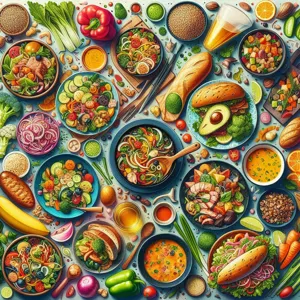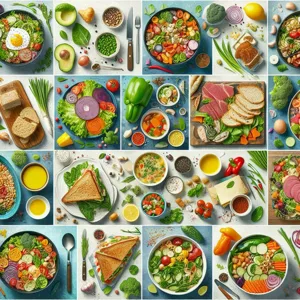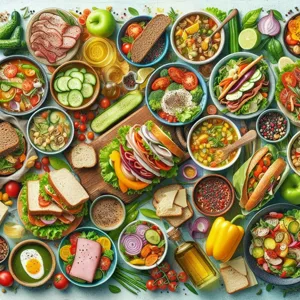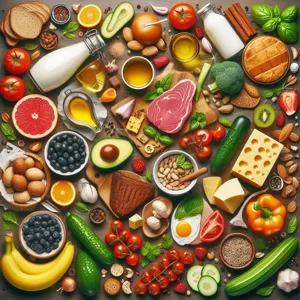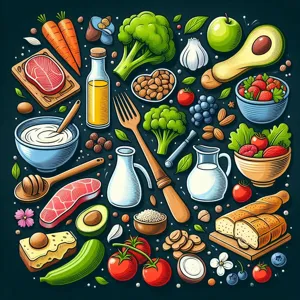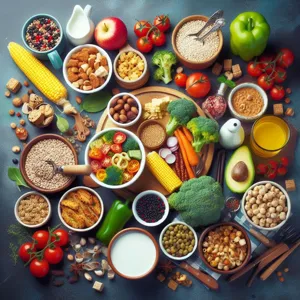There’s something undeniably alluring about the ocean, and when it comes to culinary delights, fish embodies that allure with its fresh, delicate flavors and versatile textures.
Whether you’re a seasoned chef or a home cook looking to elevate your culinary repertoire, mastering the art of cooking fish can open up a world of gastronomic possibilities. However, the key to serving up a truly exceptional seafood dish lies in the techniques you employ. In this blog post, we’ll dive into the top techniques for cooking fish perfectly, from grilling and poaching to pan-searing and baking. Discover how to bring out the natural flavors of your catch while ensuring a tender and flaky texture that will impress even the most discerning palates. So, roll up your sleeves and get ready to savor the sea with these expert tips and mouthwatering ideas that will transform your fish dishes into ocean-inspired masterpieces!
1. Understanding Different Types of Fish

When it comes to cooking fish perfectly, the first step is understanding the diverse array of fish available and how their unique characteristics influence cooking methods and flavor profiles. Fish can be broadly categorized into two main types: **lean fish** and **oily fish**, each offering a distinct culinary experience.
**Lean fish**, such as cod, halibut, and sole, are characterized by their mild flavor and firm texture. These fish are low in fat, which means they can easily dry out if overcooked. Cooking techniques that enhance their delicate nature include poaching, baking, and steaming, often complemented by light sauces or garnishes like lemon and herbs to accentuate their subtle taste.
On the other hand, **oily fish**, such as salmon, mackerel, and sardines, are rich in healthy fats, which contribute to their robust flavor and moist texture. These fish are incredibly versatile and can withstand high-heat cooking methods like grilling, broiling, or pan-searing, allowing the natural oils to caramelize and enhance their rich taste. When preparing oily fish, consider bold marinades or spices to elevate their flavor profile.
Additionally, it’s essential to recognize the importance of freshness. Fresh fish should have a clean, ocean-like smell, bright eyes, and firm flesh that bounces back when pressed. Understanding the differences between farmed and wild-caught fish is also crucial, as each type can have varying flavor profiles, textures, and environmental impacts.
By familiarizing yourself with these categories and the qualities of different fish, you’ll be well-equipped to make informed choices and employ the right cooking techniques that will bring out the best in your seafood dishes. Whether you prefer the gentle flavors of lean fish or the hearty richness of oily varieties, mastering how to cook fish perfectly begins with a solid understanding of what’s swimming in your kitchen.
2. Fresh vs. Frozen: What You Need to Know
When it comes to cooking fish perfectly, understanding the difference between fresh and frozen fish is essential. Many home cooks often find themselves torn between the two, unsure which option will yield the best flavor and texture. Let’s dive into the nuances of each to help you make an informed choice for your next seafood dish.
**Fresh Fish**: The allure of fresh fish is undeniable. When you purchase fish that has been recently caught, you benefit from its peak flavor and texture. Fresh fish boasts a delicate, flaky consistency that melts in your mouth and a subtle brininess that can elevate any dish. Look for clear, bright eyes and vibrant skin when selecting fresh fish; these indicators are signs of quality. However, keep in mind that fresh fish has a shorter shelf life, so it’s best consumed within a day or two of purchase. If you’re buying fresh fish, ensure you store it properly on ice or in the coldest part of your refrigerator to preserve its freshness.
**Frozen Fish**: On the other hand, frozen fish can be a game-changer in terms of convenience and availability. Many frozen fish products are flash-frozen immediately after being caught, which locks in their freshness and nutrients. This process often preserves the quality better than you might expect, making frozen fish a viable option. Additionally, frozen fish is readily available year-round, allowing you to enjoy a wider variety without the constraints of seasonal availability. When choosing frozen fish, look for products that are vacuum-sealed to prevent freezer burn, and opt for those that have been frozen without additives or preservatives for the healthiest choice.
Both fresh and frozen fish have their merits, and the best choice ultimately depends on your cooking needs and preferences. If you’re looking for a quick weeknight meal, frozen fish can save the day without sacrificing quality. On the other hand, if you’re preparing a special occasion dinner, fresh fish can provide that exquisite touch. Understanding these differences will empower you to make the best choice, ensuring every fish dish you create is nothing short of spectacular.
3. Essential Tools for Cooking Fish
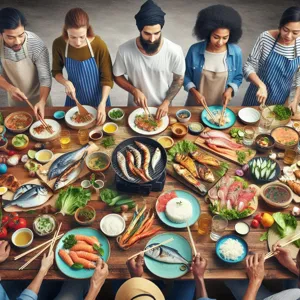
When it comes to cooking fish perfectly, having the right tools in your culinary arsenal can make all the difference. Here’s a look at some essential tools that every home cook should consider to elevate their fish cooking game.
**1. A High-Quality Fish Spatula**
A fish spatula is an indispensable tool for anyone who cooks fish regularly. Its thin, flexible design allows you to slide easily under delicate fillets without breaking them apart. Look for one with a slotted surface to help drain excess oil or juices as you lift the fish from the pan, ensuring a beautifully presented dish every time.
**2. A Reliable Instant-Read Thermometer**
Fish is notoriously tricky to cook just right, as it can go from perfectly flaky to overcooked in a matter of minutes. An instant-read thermometer takes the guesswork out of cooking, allowing you to check the internal temperature quickly. aim for 145°F (63°C) for most fish; this ensures that it’s safely cooked while retaining moisture and flavor.
**3. A Nonstick or Cast Iron Skillet**
The choice of skillet can greatly influence how your fish turns out. A nonstick skillet is ideal for cooking delicate fish like sole or tilapia, preventing it from sticking and breaking apart during the cooking process. On the other hand, a well-seasoned cast iron skillet is perfect for heartier fish like salmon or tuna, providing excellent heat retention and a beautiful sear.
**4. A Fish Cleaning Kit**
If you’re starting with whole fish, a fish cleaning kit is essential. Look for a set that includes a fillet knife, a scaler, and a cutting board. A sharp fillet knife will allow you to create clean cuts, while a scaler helps to remove scales without damaging the flesh. This preparation step is critical to ensuring that your fish is not only ready to cook but also that it tastes as fresh as possible.
**5. A Good Quality Steamer**
Steaming is a healthy and flavorful way to prepare fish, preserving its natural moisture and delicate flavors. A good quality steamer, whether it’s a bamboo steamer or a stainless steel multi-tiered model, can enhance your cooking experience. Add herbs, lemon slices, or aromatic vegetables to the steaming water for an infusion of flavor that will elevate your dish.
Equipping your kitchen with these essential tools will not only streamline the cooking process but also ensure that your fish dishes turn out perfectly every time. With the right equipment at your disposal, you’ll be well on your way to savoring the sea’s bounty like a pro!
4. Preparing Fish: Cleaning and Filleting Tips
Preparing fish for cooking is an art that can significantly enhance your culinary experience. The first step in this process is cleaning, which is crucial to ensure that your meal is not only delicious but also safe to eat. Start by rinsing the fish under cold running water to remove any slime or debris. It’s essential to use a clean surface and a sharp filleting knife to make the task smoother.
When it comes to gutting, make a shallow incision along the belly of the fish from the tail to the head. Be careful not to cut too deep, as you want to avoid puncturing the internal organs. With a steady hand, open the fish up and gently remove the entrails, discarding them properly. It’s wise to have a bowl or container ready for this purpose. Rinse the cavity thoroughly to remove any residual blood or impurities.
Next, we move on to filleting. Place the fish on a cutting board, belly side down, and secure it with a damp cloth to prevent slipping. Starting at the head and using your knife, cut along the back bone, applying light pressure to separate the flesh from the spine. Follow the rib cage with your knife to ensure you extract as much meat as possible. Once you have one fillet, flip the fish over and repeat the process on the other side.
As you work, keep an eye out for pin bones; these small, slender bones can be a nuisance when eating. Use tweezers to remove them carefully, ensuring a smooth dining experience. After filleting, rinse the fish fillets under cold water and pat them dry with paper towels. Properly cleaning and filleting your fish not only prepares it for cooking but also elevates the overall flavor and texture, setting the stage for a truly memorable meal. Now you’re ready to savor the sea with confidence!
5. The Importance of Marinating: Techniques and Recipes

Marinating fish is not just a way to infuse flavor; it’s a technique that enhances the overall texture and tenderness of your catch, transforming a simple meal into a culinary masterpiece. The process of marinating involves soaking the fish in a seasoned liquid, typically composed of acidic ingredients like citrus juice or vinegar, combined with oils, herbs, and spices. This delightful combination not only penetrates the fish, imparting vibrant flavors, but also helps break down proteins, ensuring a moist and succulent result.
When marinating fish, the key is to strike the right balance between flavor and time. Depending on the type of fish, a marinade of 15 to 30 minutes is usually sufficient. Delicate fish like sole or flounder benefit from shorter marination times, allowing them to absorb the flavors without becoming overly mushy. Heartier fish, such as salmon or swordfish, can withstand a longer soak, typically up to an hour, allowing the flavors to permeate deeper.
To elevate your marinating game, consider experimenting with various ingredient combinations. A classic lemon-dill marinade can brighten up grilled salmon, while a soy-ginger mixture can add an Asian flair to your teriyaki tuna steaks. For a more adventurous twist, try a spicy harissa marinade for a bold flavor infusion or a tropical pineapple-coconut blend that transports your taste buds to a sunny beach.
Don’t forget to include aromatic herbs like cilantro, parsley, or basil, along with spices like cumin, paprika, or even a hint of chili for added depth. And for those looking to add a touch of sweetness, a drizzle of honey or maple syrup can create a beautifully balanced marinade that enhances the natural flavors of the fish.
Once marinated, your fish is ready for the grill, oven, or stovetop, and the result is sure to impress. With these techniques and recipes in your culinary arsenal, you’ll discover that marinating fish is not just an important step; it’s an essential part of creating delicious, restaurant-quality meals right in your own kitchen. Savor the flavors, and let the ocean’s bounty shine through in every bite!
6. Cooking Methods: Grilling, Baking, and Poaching
When it comes to cooking fish to perfection, the method you choose can make all the difference in flavor, texture, and presentation. Each technique brings out unique qualities in the fish, allowing you to explore a delightful spectrum of culinary possibilities. Let’s dive into three popular cooking methods: grilling, baking, and poaching.
**Grilling:** Grilling fish adds a smoky char that complements its natural flavors beautifully. The high heat of the grill caramelizes the fish’s exterior while sealing in moisture, resulting in a tender, flaky interior. For the best results, choose firm fish like salmon, tuna, or swordfish that can withstand the heat. Marinating the fish beforehand can enhance its flavor profile, while a simple seasoning of salt, pepper, and a squeeze of lemon can let the fish shine. Remember to oil the grill grates to prevent sticking and use a fish spatula for easy flipping.
**Baking:** Baking is an incredibly versatile method that allows for even cooking with minimal effort. Simply season your fish, place it on a baking sheet lined with parchment paper or foil, and let the oven work its magic. This method is ideal for delicate fish like sole or cod, which can easily fall apart on the grill. To elevate your baked fish, consider using aromatics such as garlic, herbs, and citrus slices, or even enclose it in parchment paper for a French “en papillote” technique. This not only locks in moisture but also infuses the fish with fragrant flavors as it steams in its own juices.
**Poaching:** For a gentle, healthy cooking method, poaching is a superb choice. This technique involves simmering fish in a flavored liquid—think broth, wine, or even water infused with herbs and spices—at a lower temperature. Poaching is particularly well-suited for delicate fish like trout or flounder, ensuring they remain moist and tender without the risk of drying out. Serve your poached fish with a drizzle of the poaching liquid or a light sauce for a dish that feels elegant yet effortless.
By mastering these cooking methods, you’ll unlock a world of flavor and delight in your fish dishes. Each technique offers its own set of advantages and can be tailored to your personal taste, ensuring that every meal is a celebration of the sea’s bounty. So fire up the grill, preheat the oven, or gently simmer your fish; with these methods, perfection is just a recipe away.
7. Mastering the Art of Pan-Searing Fish
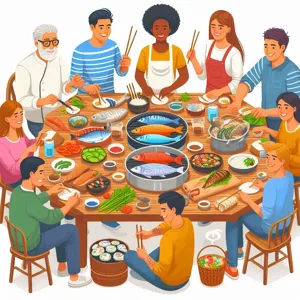
Pan-searing fish is a technique that not only enhances the natural flavors of the seafood but also creates a beautifully crisp exterior that contrasts wonderfully with the tender, flaky interior. To master this art, begin by selecting the right cut of fish—firm varieties like salmon, swordfish, or sea bass are ideal as they hold up well during cooking.
Start with a clean, dry fish fillet; moisture is the enemy of a good sear. Pat the fish dry with paper towels to remove any excess moisture, then season generously with salt and pepper, allowing the flavors to penetrate the flesh. The choice of skillet is crucial; a heavy, cast-iron or stainless-steel pan retains heat well, providing the ideal surface for achieving that coveted golden crust.
Heat your skillet over medium-high heat until it’s hot but not smoking. Add a splash of high-smoke-point oil, such as canola or grapeseed, and swirl it around the pan. Once the oil shimmers, it’s time to introduce the fish to the pan, placing it skin-side down (if applicable). This initial contact with the hot surface is what creates the delicious sear, so resist the urge to move the fish around too much—let it do its thing.
After a few minutes, you’ll notice the edges of the fish turning a beautiful golden brown. To ensure even cooking, gently flip the fish with a spatula, cooking the other side until it reaches your desired doneness. A handy tip is to use a meat thermometer; fish is perfectly cooked when it reaches an internal temperature of 145°F (63°C).
Once removed from the heat, let the fish rest for a couple of minutes before serving. This allows the juices to redistribute, resulting in a moist and flavorful bite every time. To elevate your dish, consider finishing with a squeeze of fresh lemon juice or a drizzle of herb-infused olive oil. Pan-seared fish is not just a meal; it’s an experience, one that brings the ocean’s bounty to your table with elegance and simplicity.
8. How to Achieve Perfectly Flaky Fish
Achieving perfectly flaky fish is both an art and a science, and it starts with understanding the properties of the fish you’re working with. The goal is to create a tender and moist texture that practically melts in your mouth, while still allowing those beautifully delicate flakes to separate effortlessly. Here are some essential techniques to help you master this culinary skill.
**1. Choose the Right Type of Fish**: Not all fish are created equal when it comes to flakiness. Fish like cod, haddock, and salmon are particularly known for their flaky texture when cooked properly. Look for fresh, high-quality fillets with vibrant color and a clean ocean smell.
**2. Temperature Matters**: Before cooking, allow your fish to come to room temperature for about 15-20 minutes. This helps it cook evenly, preventing the outside from overcooking while the inside remains underdone.
**3. Use the Right Cooking Method**: Different cooking methods yield varying results. Baking and poaching are excellent for achieving flaky fish. When baking, use a moderate temperature, around 375°F (190°C), and wrap the fish in parchment paper or foil to create a steaming effect. When poaching, keep the water just below boiling; this gentle heat allows the fish to cook slowly, preserving its moisture and encouraging flakiness.
**4. Don’t Overcook**: This is the golden rule when it comes to cooking fish. The moment fish reaches an internal temperature of 145°F (63°C), it’s done. Use a fork to gently prod the fish; if it flakes easily without resistance, it’s ready to come off the heat. Overcooking causes fish to dry out, resulting in a tough texture rather than the desired flakiness.
**5. Rest Your Fish**: Just like any protein, letting your fish rest for a few minutes after cooking allows the juices to redistribute, enhancing its flavor and texture.
**6. The Right Tools**: A good fish spatula is your best friend in the kitchen. Its thin, flexible design allows you to lift the delicate fillets without breaking them apart, ensuring that the beautiful, flaky texture remains intact as you serve.
By incorporating these techniques into your cooking routine, you’ll be well on your way to serving fish that not only looks appealing but also has that coveted flaky texture that keeps diners coming back for more. So, roll up your sleeves, and let the flavors of the sea shine through in each perfectly cooked bite!
9. Flavor Pairings: Herbs, Spices, and Sauces
When it comes to cooking fish, the right flavor pairings can elevate your dish from ordinary to extraordinary. Fish often has a delicate flavor profile that can be beautifully enhanced with the right combination of herbs, spices, and sauces. Understanding these pairings not only complements the inherent taste of the fish but also allows you to explore a world of culinary creativity.
**Herbs** are a classic choice for fish, with fresh options like dill, parsley, cilantro, and basil standing out for their ability to add brightness and freshness. Dill works particularly well with salmon, while parsley can enhance almost any white fish, lending a clean and crisp flavor. For a Mediterranean twist, try pairing fish with oregano and thyme, which provide earthy notes that can balance the dish perfectly.
**Spices**, on the other hand, can add depth and warmth to your seafood creations. A sprinkle of smoked paprika can introduce a subtle smokiness, while cumin adds a warm, nutty flavor that pairs beautifully with grilled fish. For those who enjoy a kick, a dash of cayenne or chili powder can spice things up, especially in dishes inspired by Latin or Asian cuisines.
**Sauces** are the final touch that can tie your entire dish together. A simple lemon butter sauce can brighten up a fillet, while a rich garlic and herb sauce can create a decadent experience. For a burst of flavor, consider a mango salsa or a zesty chimichurri, which not only add vibrant colors to the plate but also bring a fresh, tangy dimension to the meal.
Experimenting with different combinations of herbs, spices, and sauces opens up a treasure trove of possibilities, allowing you to customize your fish dishes to suit any palate. Whether you’re grilling, baking, or pan-searing, these flavor pairings will not only enhance the natural taste of the fish but will also make your culinary creations unforgettable. So, don’t shy away from experimenting—your taste buds will thank you!
10. Common Mistakes to Avoid When Cooking Fish
Cooking fish can be a delightful culinary adventure, but it’s easy to fall into some common pitfalls that can lead to disappointing results. To help you achieve that perfect fillet, here are a few mistakes to avoid when cooking fish.
Firstly, **overcooking** is perhaps the most prevalent error. Fish cooks quickly, and the difference between a moist, flaky texture and a dry, rubbery one can be mere seconds. A good rule of thumb is to cook fish for about 10 minutes per inch of thickness, flipping it halfway through. Using a meat thermometer can also be a lifesaver; fish is perfectly cooked when it reaches an internal temperature of 145°F (63°C).
Another mistake is **insufficient seasoning**. Fish has a delicate flavor that can be enhanced with the right herbs, spices, and marinades. Don’t shy away from experimenting with lemon juice, garlic, fresh herbs, or a sprinkle of sea salt to elevate your dish. Remember, a little seasoning goes a long way, so balance is key.
Additionally, many home cooks neglect **the importance of a hot pan**. Whether you’re grilling or pan-searing, starting with a hot surface ensures a beautiful sear and helps prevent sticking. If you’re using a non-stick skillet, preheat it before adding oil, and if you’re grilling, make sure the grates are preheated and well-oiled to avoid tearing the fish when flipping.
Finally, be mindful of **the quality of your fish**. Freshness matters tremendously when it comes to seafood. Always look for bright, clear eyes, firm flesh, and a mild ocean scent. Avoid purchasing fish that looks dull or has a strong, fishy odor. Sourcing your fish from reputable markets or local fishmongers can make a significant difference in your culinary creation.
By steering clear of these common mistakes, you’ll not only enhance your cooking techniques but also ensure that every fish dish you serve is a delectable masterpiece that will have everyone coming back for seconds!
11. Serving Suggestions: Creating Beautiful Fish Dishes
When it comes to serving fish, presentation is just as important as flavor. A beautifully plated dish not only enhances the dining experience but also elevates the appeal of your culinary creation. Here are some inspiring serving suggestions to help you create stunning fish dishes that will impress your guests and make your meals memorable.
**Colorful Accompaniments**: Start by incorporating a vibrant array of colors on the plate. Use seasonal vegetables such as roasted asparagus, sautéed bell peppers, or a medley of cherry tomatoes to add visual interest. Consider a fresh salad with mixed greens, radishes, and edible flowers to bring freshness and a pop of color to your dish.
**Garnishes and Sauces**: A well-chosen garnish can transform a simple plate into a work of art. Fresh herbs like dill, parsley, or cilantro add a burst of color and a hint of flavor. A drizzle of vibrant sauce, such as a bright green chimichurri or a tangy citrus beurre blanc, can complement the fish beautifully. Remember, a little goes a long way—aim for a delicate touch that enhances rather than overwhelms.
**Textural Contrast**: Introduce contrasting textures to create a more dynamic dish. Pair your flaky, tender fish with crispy elements like fried capers, toasted breadcrumbs, or a sprinkle of crushed nuts. This contrast adds an exciting crunch that will delight your diners and keep them coming back for more.
**Elegant Arrangements**: Pay attention to the arrangement on the plate. Position the fish slightly off-center for a more modern look, and consider using a ring mold for grains or vegetables to create height and structure. Layering elements can add depth, creating a visually appealing stack of flavors.
**Seasonal Themes**: Tailor your serving suggestions to the season or the occasion. In summer, a light, refreshing presentation with citrus and fresh herbs might be ideal. In contrast, a heartier, more comforting dish in winter could feature roasted root vegetables and a rich sauce.
By thoughtfully considering your serving suggestions, you can transform a simple fish dish into an impressive culinary experience. Remember, the goal is not just to satisfy the palate but also to delight the eyes, making every meal a feast for the senses. So, roll up your sleeves, get creative, and let your imagination guide you as you plate your next fish dish!
12. Sustainability in Seafood: Choosing Wisely
In today’s culinary landscape, the call for sustainability extends to every corner of the kitchen, and seafood is no exception. As we savor the ocean’s bounty, it’s essential to prioritize not just taste and freshness, but also the environmental impact of our choices. When selecting fish, consider sourcing options that are both sustainable and ethical. Look for labels such as Marine Stewardship Council (MSC) or Aquaculture Stewardship Council (ASC), which signify that the seafood has been harvested or farmed in ways that maintain healthy fish populations and minimize environmental damage.
Moreover, embracing seasonal seafood can elevate your dishes while supporting local fishing communities. Different species peak at various times of the year, and by aligning your cooking with these natural cycles, you contribute to the health of marine ecosystems.
It’s also beneficial to educate yourself about the fish you choose to cook. Some species, like bluefin tuna and certain shark varieties, are facing significant population declines, while others, such as farmed tilapia or Pacific sardines, are more abundantly available and can be enjoyed guilt-free. Utilize resources like the Seafood Watch app, which provides guidance on making environmentally conscious seafood choices based on your location.
By prioritizing sustainability in your seafood selection, you not only set the stage for flavorful, responsible meals but also play a part in preserving our oceans for future generations. Cooking fish perfectly is not just about technique; it’s also about being mindful of the impact your choices have on the world around you. Savor each bite knowing that you’ve made a wise decision for both your palate and the planet.
13. Fish Cooking Times: A Quick Reference Guide
When it comes to cooking fish, timing is everything. Overcooking can lead to dry, rubbery fillets, while undercooking can leave you with a dish that’s unsafe to eat. To help you master the art of cooking fish perfectly, we’ve put together a quick reference guide that outlines optimal cooking times based on various methods and types of fish.
**Grilling:** For firm, meaty fish such as salmon or swordfish, aim for about 6 to 8 minutes per side over medium heat. If you’re grilling delicate fish like flounder or tilapia, reduce the time to about 3 to 4 minutes per side, keeping a close watch to prevent it from breaking apart.
**Baking:** When baking fish in the oven, a good rule of thumb is to cook at 400°F (200°C) for approximately 10 minutes per inch of thickness. For example, a 1-inch thick piece of cod will need about 10 minutes, while a thicker, 2-inch piece may require up to 20 minutes. Always check for doneness by inserting a fork into the thickest part of the fish; it should flake easily and appear opaque.
**Poaching:** Poaching is a gentle cooking method that can be particularly beneficial for delicate fish. In simmering water or broth, cook fish fillets for about 10 minutes per inch of thickness. For instance, a 1-inch thick piece of sole will typically be ready in about 10 minutes.
**Searing:** Searing fish in a hot pan with a little oil will give you a crisp exterior while keeping the inside tender. Cook fish fillets for about 3 to 4 minutes on each side, depending on thickness. Keep an eye on the edges; when they turn opaque, it’s usually a sign that the fish is close to being done.
**Frying:** For deep-frying, fish should be cooked for about 4 to 6 minutes, depending on the thickness. The batter should be golden brown, and the fish should flake easily with a fork.
Remember, the key to perfect fish is not only timing but also quality. Always start with the freshest fish you can find and use a meat thermometer if you’re unsure. The FDA recommends an internal temperature of 145°F (63°C) for safely cooked fish. With this quick reference guide in hand, you’ll be well on your way to mastering fish cooking times, ensuring your seafood dishes are both delicious and perfectly cooked every time.
14. Pairing Fish with Sides and Wines
Pairing fish with the right sides and wines can elevate your seafood dish from a simple meal to an extraordinary culinary experience. The delicate flavors of fish can be complemented or contrasted beautifully with a variety of accompaniments, enhancing the overall dining experience.
When it comes to sides, consider the texture and flavor profile of the fish you are serving. For lighter, flaky fish like cod or sole, fresh salads or steamed vegetables can provide a refreshing counterbalance. Think of a citrusy arugula salad or sautéed asparagus drizzled with a light vinaigrette that will highlight the fish’s natural flavors without overwhelming them. On the other hand, heartier fish such as salmon or swordfish can stand up to richer sides. Creamy risottos, roasted root vegetables, or a savory potato gratin can create a satisfying harmony on the plate.
Now, let’s talk about wine, which plays a pivotal role in the overall presentation of your meal. A crisp white wine, such as Sauvignon Blanc or Pinot Grigio, pairs wonderfully with lighter fish, enhancing their fresh and delicate taste. These wines often have zesty acidity that can cut through richer sauces or complement a squeeze of lemon on your dish. For those rich, oily fish varieties, a light red like Pinot Noir or a robust white like Chardonnay can create a delightful contrast, bringing out the flavors of both the wine and the fish.
Don’t hesitate to experiment with various regional wines that correspond to the fish you’re cooking. For instance, serving a Mediterranean sea bass with a chilled glass of Verdicchio can transport your taste buds straight to the coastal towns of Italy. Similarly, pairing a spicy blackened catfish with a slightly sweet Riesling can create an exciting flavor explosion.
Ultimately, pairing fish with the right sides and wines is about balance, bringing together complementary flavors that create a memorable dining experience. So, the next time you prepare a fish dish, take a moment to consider the perfect accompaniments, and watch as your meal transforms into a delightful feast for the senses.
15. Conclusion: Embracing the Ocean’s Bounty in Your Kitchen
As we reach the conclusion of our culinary journey through the waves, it’s clear that cooking fish is not just a technique; it’s an art that embraces the essence of the ocean’s bounty. With every fillet, you have the opportunity to celebrate the delicate flavors, vibrant textures, and nutritional benefits that seafood offers. By mastering the techniques we’ve explored—whether it’s the subtle finesse of poaching, the crispy allure of pan-searing, or the smoky richness of grilling—you can unlock a world of culinary possibilities that will elevate your dishes and impress your guests.
But beyond the methods lies a deeper connection to the ingredients themselves. Embracing sustainable sourcing, understanding the seasonal availability of different types of fish, and respecting the environment from which they come is essential in today’s cooking landscape. Each time you prepare a fish dish, you are partaking in a tradition that spans cultures and generations, celebrating the ocean’s treasures and the communities that rely on them.
So, as you step into your kitchen, remember to savor every moment. Allow the fresh scents of the sea to inspire you, experiment with flavors, and don’t shy away from making mistakes—they are often the stepping stones to culinary mastery. Whether you’re preparing a simple weeknight dinner or an elaborate feast for friends, the ocean’s bounty is waiting to be embraced, inviting you to create delicious memories with every meal. Dive in, have fun, and let the magic of cooking fish transform your kitchen into a seaside haven!





